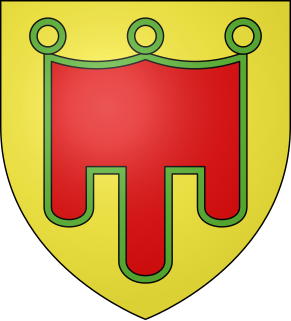Nicetius, or Nicetas, was the Count of Clermont, Duke of Auvergne, and Governor of Provence in the late sixth century.
He sent gifts to Childebert II in order to secure a dukedom. He received, as constituting his duchy, the cities of Rodez, Clermont, and Uzès. According to Gregory of Tours, though he was young at the time, he was "a man of acute insight," who "established peace in the Auvergne."

Childebert II (c.570–595) was the Merovingian king of Austrasia from 575 until his death in 595, as the eldest son of Sigebert I, and the king of Burgundy from 592 to his death, as the adopted son of his uncle Guntram.

Rodez is a small city and commune in the South of France, about 150 km northeast of Toulouse. It is the prefecture of the department of Aveyron in the region of Occitanie. Rodez is the seat of the Communauté d'agglomération du Grand Rodez, of the First Constituency of Aveyron as well as of the general Council of Aveyron.

Clermont-Ferrand is a city and commune of France, in the Auvergne-Rhône-Alpes region, with a population of 141,569 (2012). Its metropolitan area had 467,178 inhabitants at the 2011 census. It is the prefecture (capital) of the Puy-de-Dôme department. Olivier Bianchi is its current mayor.
In 585, he participated in a war against the Visigoths; Gregory strongly criticises his conduct in the war ("crime and deception"). Afterwards, he patrolled the border between Septimania (the Gothic province of Narbonensis) and his own Frankish territory, the so-called "Dukedom of Auvergne."

The Visigoths were the western branches of the nomadic tribes of Germanic peoples referred to collectively as the Goths. These tribes flourished and spread throughout the late Roman Empire in Late Antiquity, or what is known as the Migration Period. The Visigoths emerged from earlier Gothic groups who had invaded the Roman Empire beginning in 376 and had defeated the Romans at the Battle of Adrianople in 378. Relations between the Romans and the Visigoths were variable, alternately warring with one another and making treaties when convenient. The Visigoths invaded Italy under Alaric I and sacked Rome in 410. After the Visigoths sacked Rome, they began settling down, first in southern Gaul and eventually in Hispania, where they founded the Visigothic Kingdom and maintained a presence from the 5th to the 8th centuries AD.

Septimania is a historical region in modern-day south of France. It referred to the western part of the Roman province of Gallia Narbonensis that passed to the control of the Visigoths in 462, when Septimania was ceded to their king, Theodoric II. Under the Visigoths it was known as simply Gallia or Narbonensis. Septimania territory roughly corresponds with the former administrative region of Languedoc-Roussillon that merged into the new administrative region of Occitanie. Septimania passed briefly to the Emirate of Córdoba, which had been expanding from the south during the eighth century before its subsequent conquest by the Franks, who by the end of the ninth century termed it Gothia or the Gothic March.

The Franks were a collection of Germanic peoples, whose name was first mentioned in 3rd century Roman sources, associated with tribes on the Lower and Middle Rhine, on the edge of the Roman Empire. Later the term was associated with later Romanized Germanic dynasties within the collapsing Roman Empire, who eventually commanded the whole region between the rivers Loire and Rhine. They then imposed power over many other post-Roman kingdoms and Germanic peoples, and still later they were given recognition by the Catholic Church as successors to the old rulers of the Western Roman Empire.
In 587, he was made governor of Provence (the diocesan province of Marseille) as well. In 588 Theodore, Bishop of Marseille, complained to the king that there had been a plague in Provence. Nicetius was replaced in the countship of Clermont by one Eulalius.

Provence is a geographical region and historical province of southeastern France, which extends from the left bank of the lower Rhône River to the west to the Italian border to the east, and is bordered by the Mediterranean Sea to the south. It largely corresponds with the modern administrative région of Provence-Alpes-Côte d'Azur, and includes the départements of Var, Bouches-du-Rhône, Alpes-de-Haute-Provence and parts of Alpes-Maritimes and Vaucluse. The largest city of the region is Marseille.

Marseille is the second-largest city of France. The main city of the historical province of Provence, it is the prefecture of the department of Bouches-du-Rhône and region of Provence-Alpes-Côte d'Azur. It is located on the Mediterranean coast near the mouth of the Rhône. The city covers an area of 241 km2 (93 sq mi) and had a population of 852,516 in 2012. Its metropolitan area, which extends over 3,173 km2 (1,225 sq mi) is the third-largest in France after Paris and Lyon, with a population of 1,831,500 as of 2010.

Gaius Sollius Modestus Apollinaris Sidonius, better known as Saint Sidonius Apollinaris, was a poet, diplomat, and bishop. Sidonius is "the single most important surviving author from fifth-century Gaul" according to Eric Goldberg. He was one of four Gallo-Roman aristocrats of the fifth- to sixth-century whose letters survive in quantity; the others are Ruricius bishop of Limoges, Alcimus Ecdicius Avitus, bishop of Vienne and Magnus Felix Ennodius of Arles, bishop of Ticinum. All of them were linked in the tightly bound aristocratic Gallo-Roman network that provided the bishops of Catholic Gaul. His feast day is 21 August.

The Arverni were a Celtic tribe. The tribe was located in what is today the French Auvergne region, which derives its name from the Arverni. One of the most powerful tribes in ancient Gaul, the Arverni opposed the Romans on several occasions. One of their most important strongholds was Gergovia, near the present-day commune of Clermont-Ferrand.

Stremonius or Saint Austremonius or Saint Stramonius or Austromoine, the "apostle of Auvergne," was the first bishop of Clermont.

Auvergne is a former administrative region of France, comprising the four departments of Allier, Puy-de-Dôme, Cantal and Haute-Loire. Since 1 January 2016, it has been part of the new region Auvergne-Rhône-Alpes.

The history of the Auvergne dates back to the early Middle Ages, when it was a historic province in south central France. It was originally the feudal domain of the Counts of Auvergne.
La Tour d'Auvergne was a noble French dynasty. Its senior branch, extinct in 1501, held two of the last large fiefs acquired by the French crown, the counties of Auvergne and Boulogne, for about half a century. Its cadet branch, extinct in 1802, ruled the duchy of Bouillon in the Southern Netherlands from 1594, and held the dukedoms of Albret and Château-Thierry in the peerage of France since 1660. The name was also borne by Philippe d'Auvergne, an alleged collateral of the original Counts of Auvergne, and was adopted by the famous soldier Théophile Corret de la Tour d'Auvergne, who descended from an illegitimate line of the family.

Gare de la Part-Dieu is the primary railway station in Lyon, France. It is situated on the Paris-Lyon-Marseille railway. The train services are mainly operated by SNCF with frequent TGV high-speed and TER regional services with Eurostar and Deutsche Bahn also operating few services through the station. Lyon's secondary station is Gare de Lyon-Perrache south of the city center.

Saint Nicetius was a bishop of Trier, born in the latter part of the fifth century, exact date unknown; died in 563 or more probably 566.
Saint Nicetius was Archbishop of Lyon, then Lugdunum, France, during the 6th century. He served from 552 or 553.
Dynamius or Dinamius was the Rector of Provence from 575, when he replaced Albinus. At the time, Provence and Austrasia lay within the kingdom of Childebert II, though half of Marseille, the chief Provençal city, was under the lordship of Guntram, King of Burgundy.
Ecdicius Avitus was a Gallo-Roman aristocrat, senator, and magister militum praesentalis from 474 until 475.

The Roman Catholic Archdiocese of Clermont is an Archdiocese of the Latin Rite of the Roman Catholic Church in France. The diocese comprises the department of Puy-de-Dôme, in the Region of Auvergne. The Archbishop's seat is Clermont-Ferrand Cathedral. Throughout its history Clermont was the senior suffragan of the Archdiocese of Bourges. It became a metropolitan see itself, however, in 2002. The current Archbishop is François Kalist.
Saint Gal of Clermont was the sixteenth Bishop of Clermont, holding that see from 527 to 551. This bishop of Clermont shares a name with a later bishop of the diocese, who, though less illustrious than the first Gal, is also revered as a saint. Gal played important role in the politics of the Church, as the Council of Clermont (535) was hosted under his episcopate. He was the uncle and teacher of Gregory of Tours.
Magneric was a Frankish bishop of Trier. He is a Catholic and Orthodox saint, with a feast day on July 25. Magneric was one of the first bishops with a Germanic name, and had one of the first Swiss francs on a bishop's throne. He was a friend and admirer of Gregory of Tours, mentioned in his History of the Franks, and ordained St Géry, one of his disciples, who became bishop of Cambrai-Arras on the ascent of King Childebert II. Venantius Fortunatus described the Bishop as virtuous and charitable, and an "ornament of bishops".
Saint Bonitus (623–710) was born in France and held a number of important positions including being appointed governor of Marseilles in 667 and Bishop of Auvergne. He was also chancellor and referendary in Francia.
Saint Julian of Brioude was a 4th-century martyr from the Auvergne region of France. Although the main focus of his worship was in the small village of Brioude, he was originally from the city of Vienne, and also associated with Clermont. He was most famous through his association with an aristocratic family of bishops of the time, his most notable proponents being St. Gallus of Clermont and St. Gregory of Tours. Gregory wrote a vita of Julian, but his attempts to expand the saint's cult from the Auvergne to Touraine and Aquitaine were unsuccessful, and Julian is now only remembered through his basilica in the town of Brioude itself.
















